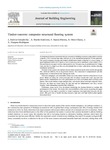Mostrar o rexistro simple do ítem
Timber-Concrete Composite Structural Flooring System
| dc.contributor.author | Estévez-Cimadevila, Javier | |
| dc.contributor.author | Martín-Gutiérrez, Emilio | |
| dc.contributor.author | Suárez-Riestra, Félix | |
| dc.contributor.author | Otero-Chans, Dolores | |
| dc.contributor.author | Vázquez-Rodríguez, Pepe | |
| dc.date.accessioned | 2022-06-27T09:04:24Z | |
| dc.date.available | 2022-06-27T09:04:24Z | |
| dc.date.issued | 2022-05-15 | |
| dc.identifier.citation | Estévez-Cimadevila, J., E. Martín-Gutiérrez, F. Suárez-Riestra, D. Otero-Chans, J.A. Vázquez-Rodríguez. "Timber-concrete composite structural flooring system". Journal of Building Engineering 49 (May 2022): 104078. doi: 10.1016/j.jobe.2022.104078 | es_ES |
| dc.identifier.issn | 2352-7102 | |
| dc.identifier.uri | http://hdl.handle.net/2183/30991 | |
| dc.description.abstract | [Abstract] An integrated solution is presented for the execution of building structures using timber-concrete composite (TCC) sections that make efficient use of the mechanical properties of both materials. The system integrates flooring and shaped prefabricated beams composed of a lower flange of glued laminated timber (GLT) glued to one or more plywood or laminated veneer lumber (LVL) ribs and linked to an upper concrete slab poured in situ. The parts may be prefabricated in T shape (only one rib), in π shape (two ribs), or with multiple ribs to create wider pieces, thereby reducing installation operations. The basis of the system is the timber-concrete shear connection in the form of holes through the ribs, which are filled by the in situ-poured concrete. The connection is complemented with the arrangement of reinforcement bars through the holes. Three test campaigns were undertaken. Shear tests of the timber-concrete connection in 12 test pieces. Shear test along the wood-wood glue line (72 planes tested) and wood -plywood (24 planes tested). Delamination test of the glued planes (24 wood-wood planes and 8 wood-plywood planes). The results indicate a high strength joint, with ductile failure and high composite effect. Likewise, the shear test results along the glue line and the delamination tests show section integrity under demanding hygrothermal conditions. Preliminary sizing curves were developed considering the Gamma Method to evaluate the performance of the system. The results show the possibilities of the system, as pouring the upper slab concrete in situ makes it possible to create continuous semi-rigid joints between the elements. This gives rise to slender flooring structures, light and with high stiffness plane against horizontal forces. | es_ES |
| dc.description.sponsorship | This study is part of the research project ‘‘High-performance timber-concrete-composite hollow-core floors for sustainable and eco-efficient construction (AlveoTCC)”. The study developed was financed by the Spanish Ministry of Science and Innovation | |
| dc.language.iso | eng | es_ES |
| dc.publisher | Elsevier | es_ES |
| dc.relation.uri | https://doi.org/10.1016/j.jobe.2022.104078 | es_ES |
| dc.rights | Atribución-NoComercial-SinDerivadas 4.0 Internacional | es_ES |
| dc.rights.uri | http://creativecommons.org/licenses/by-nc-nd/4.0/ | * |
| dc.subject | Timber-concrete composite | es_ES |
| dc.subject | Timber flooring systems | es_ES |
| dc.subject | Mixed beams | es_ES |
| dc.subject | Shear connector | es_ES |
| dc.title | Timber-Concrete Composite Structural Flooring System | es_ES |
| dc.type | info:eu-repo/semantics/article | es_ES |
| dc.rights.access | info:eu-repo/semantics/openAccess | es_ES |
| UDC.journalTitle | Journal of Building Engineering | es_ES |
| UDC.volume | 49 | es_ES |
| UDC.startPage | 104078 | es_ES |
Ficheiros no ítem
Este ítem aparece na(s) seguinte(s) colección(s)
-
GI-GEA - Artigos [66]






